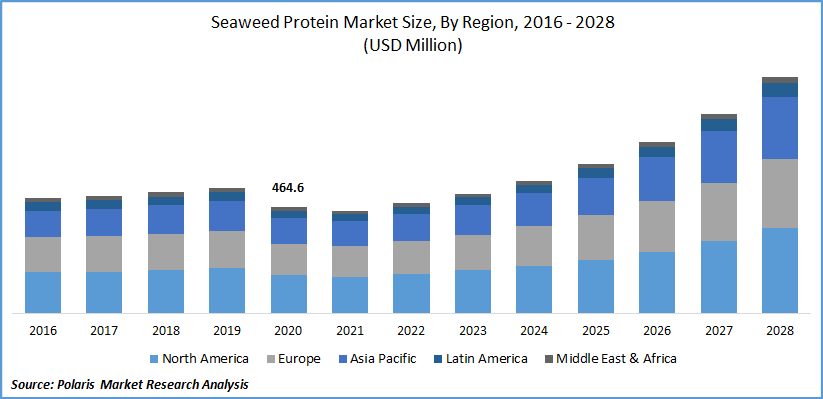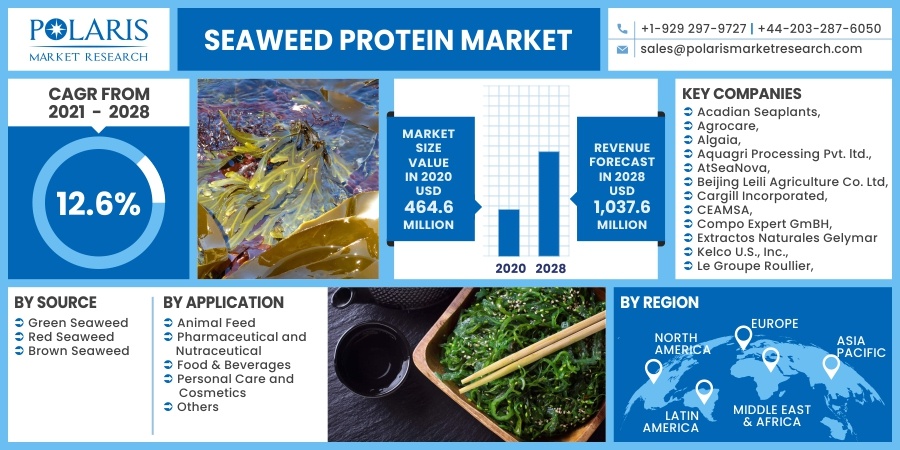
Seaweed Protein Market Share, Size, Trends, Industry Analysis Report, By Source (Green Seaweed, Red Seaweed, Brown Seaweed); By Application (Animal Feed, Pharmaceutical and Nutraceutical, Food & Beverages, Personal Care and Cosmetics, Others); By Region; Segment Forecast, 2021 - 2028
- Published Date:Oct-2021
- Pages: 101
- Format: PDF
- Report ID: PM2123
- Base Year: 2020
- Historical Data: 2016 - 2019
Report Summary
The global seaweed protein market size was valued at USD 464.6 million in 2020 and is expected to grow at a CAGR of 12.6% during forecast period. Seaweed protein provides amino acids such as proline, glycine, alanine, glutamic, arginine, and aspartic acids. Research suggests that red seaweeds contain high protein levels, whereas green seaweeds contain a moderate amount of protein, followed by brown with low protein levels. This protein is gaining popularity as an alternative and cost-effective protein source for human and animal nutrition. Growing occurrences of health disorders, increasing awareness regarding healthy eating habits, and rise in health and fitness consciousness are supplementing the market's growth. Consumers are more aware of their nutritional intake, benefits of physical exercises, and consuming food products to meet the body's nutritional requirements.
 Know more about this report: request for sample pages
Know more about this report: request for sample pages
The major factors driving the growth of the market include increasing use of functional foods, rising inclination towards vegetarian protein sources, and growing awareness regarding the benefits of market. The rising need of consumers to stay healthy accelerates the market growth. The growth in population coupled with increasing consumer awareness regarding food safety supports the seaweed protein market growth.
The global market is fuelled by the economic growth in countries such as Japan, India, and China, rising disposable income, and changing lifestyles of consumers. Additionally, technological advancements in tissue engineering and a significant rise in investments for research and development are factors expected to offer growth opportunities. However, low concentration of some essential amino acids in seaweed, high cost associated with this protein production, and the undesirable effect of excessive consumption of seaweed are expected to hamper the market growth.

Know more about this report: request for sample pages
Industry Dynamics
Growth Drivers
Seaweed protein is incorporated in animal feed owing to its nutritional and biological health benefits for livestock. It is used in the development of feed for aquaculture, monogastric livestock, and ruminants, among others. It results in enhanced overall health and growth rates in cattle. Growing meat consumption, increasing livestock industrialization, and the rising need for nutritious feed drive the growth of this segment.
Another application of this protein gaining popularity is cosmetics. Natural and organic ingredients-based products are gradually replacing synthetic cosmetic products. Cosmetics incorporated with this offer low cytotoxicity and low allergens content, increasing its demand worldwide. Lifestyle changes of consumers, growing awareness regarding skincare, and increasing inclination towards the use of natural ingredients support the growth of this segment.
The demand for this protein has increased during the pandemic owing to its potential to treat COVID-19 and related symptoms. Increasing health awareness and growing consumption of functional food and protein-based food products to increase immunity positively affects the market.
However, the COVID-19 outbreak has disrupted the supply chain across the globe. Reduced seaweed farming, decreased prices, and a limited workforce has severely impacted the market. Countries across the world have regulated the movement of individuals and goods, resulting in decreased deliveries, roadblocks, and other logistic issues. The market is expected to grow to post the pandemic and attract investments and research initiatives to increase applications of this protein.
Report Segmentation
The market is primarily segmented on the basis of source, application, and region.
|
By Source |
By Application |
By Region |
|
|
|
Know more about this report: request for sample pages
Insight by Source
On the basis of source, the market is segmented into green seaweed, red seaweed, and brown seaweed. There is likely to be high demand for red seaweed during the forecast period. It has high protein content and umami flavour. It is increasingly being used as an alternative protein in products. It promotes healthy blood circulation, reduces bad cholesterol levels, and regulates blood sugar levels. It also improves bone health and boosts the immune system. The major factors driving the growth of this segment include the increasing occurrence of lifestyle diseases, rising awareness regarding health benefits of this protein, and rising disposable income.
Insight by Application
The application segment has been divided into animal feed, pharmaceutical and nutraceuticals, food & beverages, personal care, and cosmetics. Increasing demand for organic food, growing consumption of nutritional supplements, and initiatives towards preventive healthcare drive the growth of the food and beverages segment. Some dried seaweeds include nori, wakame, and kombu, among others. Health benefits offered by this protein include regulation of thyroid function, improved gut health, and enhanced heart health. Consumers are increasingly turning towards functional food and beverages owing to their nutritional benefits and health advantages.
Geographic Overview
Asia Pacific dominated the global market in 2020. Increasing awareness regarding diet and healthy eating habits, supportive government regulations, and the growing geriatric population are some factors attributed to the growth in this region. The presence of leading market players in the region, high production and consumption of edible seaweeds, and changing lifestyles have increased the demand for this protein. Rising incidences of health disorders have resulted in increased awareness regarding healthy eating habits, boosting the market growth.
Competitive Landscape
The leading players in the seaweed protein market include Acadian Seaplants, Agrocare, Algaia, Aquagri Processing Private limited., AtSeaNova, Beijing Leili Agriculture Co. Ltd, Cargill Incorporated, CEAMSA, Compo Expert GmBH, Extractos Naturales, Gelymar S.A., Kelco U.S., Inc., Le Groupe Roullier, Qingdao Gather Great Ocean Algae Industry Group, Seasol International, Trophic LLC, Irish Seaweeds, Mara Seaweed, The Seaweed Company. These players are expanding their presence across various geographies and entering new markets in developing regions to expand their customer base and strengthen presence in the market. The companies are also introducing new innovative products in the market to cater to the growing consumer demands.
Seaweed Protein Market Report Scope
|
Report Attributes |
Details |
|
Market size value in 2020 |
USD 464.6 million |
|
Revenue forecast in 2028 |
USD 1,037.6 million |
|
CAGR |
12.6% from 2021 - 2028 |
|
Base year |
2020 |
|
Historical data |
2016 - 2019 |
|
Forecast period |
2021 - 2028 |
|
Quantitative units |
Revenue in USD million and CAGR from 2021 to 2028 |
|
Segments covered |
By Source, By Application, By Region |
|
Regional scope |
North America, Europe, Asia Pacific, Latin America, Middle East & Africa |
|
Key Companies |
Acadian Seaplants, Agrocare, Algaia, Aquagri Processing Private limited., AtSeaNova, Beijing Leili Agriculture Co. Ltd, Cargill Incorporated, CEAMSA, Compo Expert GmBH, Extractos Naturales Gelymar S.A., Kelco U.S., Inc., Le Groupe Roullier, Qingdao Gather Great Ocean Algae Industry Group, Seasol International, Trophic LLC, Irish Seaweeds, Mara Seaweed, The Seaweed Company. |
License and Pricing
Purchase Report Sections
- Regional analysis
- Segmentation analysis
- Industry outlook
- Competitive landscape
Connect with experts
Suggested Report
- Endoscopy Visualization Systems Market Share, Size, Trends, Industry Analysis Report, 2021 - 2028
- Wireless Microphone Market Share, Size, Trends, Industry Analysis Report, 2021 - 2028
- Quillaia Extracts Market Share, Size, Trends, Industry Analysis Report, 2021 - 2028
- Surgical Microscope Market Share, Size, Trends, Industry Analysis Report, 2021 - 2028
- Packaging Printing Inks Market Share, Size, Trends, Industry Analysis Report, 2021 - 2028

